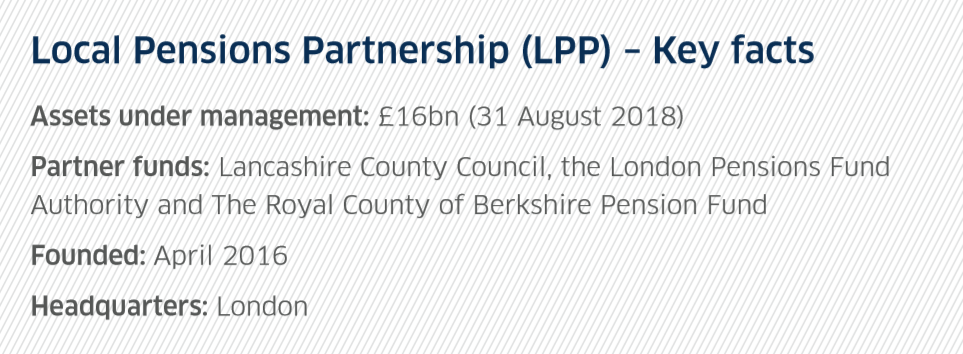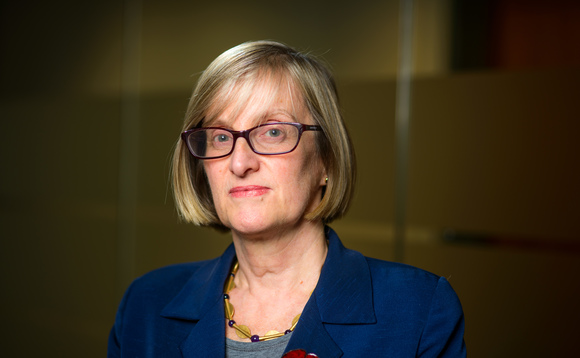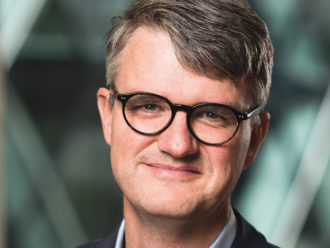How has the pooling process been for Local Pensions Partnership (LPP)?
We embarked on this before the government suggested that it was a good idea for local government pension schemes (LGPS) to do it. So we were some way ahead before the government gave the encouragement to others.
We set up in October 2015 and were operational by April 2016. So we have done all of the pooling bar real estate. Real estate should be done by the end of March.
The big thing for us is that we have pooled the management of the assets since day one, included any that are held for local investment. We managed that in-house.
We have pooled management from day one and everyone else is bringing assets in as and when they wish. It is a different approach, but a successful one, we feel. It means that we can provide advice on a holistic basis.
Why were you ahead of the game when it came to pooling?
We run a full range of services from risk management, pensions’ administration, consultancy and investment advice and services. Lancashire County Council and the London Pensions Fund Authority (LPFA) provided administration services to other pension funds. No one in those days was allowed to provide investment services. The regulations would not allow it.
It became apparent to both funds that managing investments effectively was about full delegation to an experienced team to manage some elements of the portfolio and bringing a more commercial and professional approach as well as scale.
We identified that if you wanted to eradicate the deficit and have a much more stable employer contribution rate, have a much more diversified portfolio with more invested in infrastructure and other alternatives then we needed to have the scale and expertise to do it.
Both pension funds had in-house asset management as well and employed commercial and professional individuals who had already operated in FCA-regulated environments. They had already delegated a large amount to those professionals.
So for the two primary shareholders it made sense that they found each other, they had similarities in approach and philosophy so it was a prime reason for getting together to achieve all of those points, whether it is deficit reduction, cost reduction, greater assurance or greater diversification of the portfolio. But at the centre of it was an understanding that to do it you have to look at risk, asset and liability management, whereas before most pension plans were only looking at the size of the assets, not the size of the liabilities. They were not addressing the deficit.
It is also about having good quality data and to have good quality data is about managing your pension administration well. So you understand things like longevity and have the correct liability information. That is why they decided to set LPP up to provide risk, pensions’ administration and investment advice.
It is about bringing people together, working with people who are likeminded and focusing on the returns and opportunities that are there to get the best deal for the client.
So pooling is not just about cutting costs for you?
Depending on how you do pooling you will reduce some costs, but for us it was about: “Let’s reduce costs, but let’s get greater assurance and greater diversification.” The stability of the employer contribution is important too, so cost is just one element.
How have you taken advantage of your increased fire power?
We have always had good relations with various fund managers, other pension funds and sovereign wealth funds. What we have been able to do by coming together is improve and extend those relationships. Whilst we do internal management for equities and infrastructure, we accept that we don’t do internal management for everything, but we use the skills and the knowledge of our internal managers to ensure that we pick our external managers with care and we negotiate well.
So we look for people who have a similar approach to us. Lancashire was about £7bn and LPFA was £5bn when they came together. Although they were quite sizable and had good opportunities coming their way in infrastructure, when you are £12bn more opportunities open themselves up to you that would not open up if you were £5bn.
That is also why we launched the partnership with Greater Manchester, Merseyside and West Yorkshire in 2014, to look at infrastructure opportunities, mainly within the UK.
We believe that by sharing our skills and expertise together we could find good opportunities for the pension fund and do it at a cost that would not be possible elsewhere because we were doing it directly and not adding huge costs onto the pension funds.
That has been huge success. The GLIL Infrastructure LLP partnership won a collaboration award earlier this year. It is about bringing people together, working with people who are likeminded and focusing on the returns and opportunities that are there to get the best deal for the client.
Has anything come from your discussions about collaborating with other pools?
GLIL is what we have been working with and talking to other pools about.
A number of pools have only just been set up, so for everybody it is about finding their feet. We understand what it was like when we started down this road.
There is a chairman group that meets and a chief executive group that meets. There is so much that we could be looking at doing together as we move forward, but obviously, we have to recognise that each pool is different from the others.
You have infrastructure, private equity and credit funds. Why are alternatives such a big part of your investment strategy?
It is about having a diversified strategy and ensuring that you can get the returns you need to pay the pensions.
Our focus has always been on eradicating the deficit and making sure that we have the cash to pay the pensions. So it is about having a mixed approach, you are looking at capital appreciation and income.
We have mature schemes, so it is important that our clients understand their liabilities, their cash-flow, what money they need over a 20 to 25-year horizon. So that you ensure that the money they do have is put to best use to get the returns and the income stream. Alternatives gives us an income stream.
Alternatives are considered to be illiquid. Is that an issue for you guys?
It depends on whether you are looking for capital appreciation or if you are looking for income. In some instances we are looking for income and in some instances we are looking for capital appreciation. So the answer is, “no”.
What is the strategy in global equities?
It is complementary approach. In terms of global equities, we manage a large chunk directly in-house. We are looking at large cap quality stocks and we operate a buyand-hold strategy. We are effectively in for the long-term, we are not looking for quick sale.
The whole thing for us in equities is about buy and hold.
Within that we take an active interest in how the companies are doing, not just in terms of the dividend returns, but also in how they are doing in terms of governance and various other responsible investment activities.
Why have you have signed up to the UN’s Principles for Investment?
Our founding shareholders were UN PRI signatories and it became apparent as part of pooling that LPP should be the signatory. So we changed that in August.
How is ESG being applied to your investment decisions?
We have quite an extensive responsible investment policy, which is on our website. We work closely with our clients to ensure that that is what they wish us to look at.
The primary focus is to look at the risks and opportunities to receive the risk-adjusted returns. Everything for me comes back to making sure that we are getting the right returns on a sustainable basis so that we can ensure that our clients can pay their pensions.
So the approach is to integrate all of the ESG factors into a risk evaluation. So we don’t apply exclusionary screening, but we do look at having all of the ESG factors integrated.
At every stage of the investment cycle we are looking at responsible investment. Does it work within this strategy? Does it work within our selection? Does it work with our ongoing ownership practices? It is there at every stage whether it is our internally managed global equities or externally global equities.
Is this about reducing risk or increasing returns longer term?
It is about risk-adjusted returns. We are in here for the long term. We make sure that what they are doing is not just looking at the risk-adjusted returns in the short term, but where are we going to be in the long term. How sustainable is that business? That is a question they ask us.
Your clients’ triannual valuations are scheduled for next year. How are helping them to prepare for that?
It is straight forward. We have been doing it for a number of years for our clients. In terms of looking at it from an employer risk perspective, we have an in-house team that provides services to six or seven local government pension schemes, looking at the covenants of the employers within their funds. Looking at whether there needs to be additional charges over assets or additional monies brought into ensure that a pension fund can continue to meet its obligations. We have had some excellent feedback from clients on how we work with them on that.
One the other side of the business, we work with the actuaries to help our clients understand their liabilities and how the investment strategies that they have chosen impact not just the cash-flow but the employer contribution rates as well.
We have our own in-house actuaries, so we have a close relationship with our clients and their actuaries.
We also provide risk and investment workshops for our clients. We had one the other day on our investor forum, which touched on the help that we will be providing for them over the coming months up until their valuation and then the help we will be providing after that.
[Real estate] will be our eighth pooled vehicle and achieving that in two-and-abit years is pretty good.
The valuation is very much their responsibility, it is not delegated to us, but we work closely with them to help them understand the processes and interpret some of the rules, regulations and data to help them make their own decisions.
In March you will launch a real estate element to the LPP. Why has it taken so long to gain exposure to that asset class?
This will be our eighth pooled vehicle and achieving that in two-and-a-bit years is pretty good.
In terms of why real estate is at the end, you look at the ones that are more straightforward. There has been a lot of toing and froing around regulation and legislation over the type of vehicle one can use for a real estate fund. There have been some changing views by various regulators and HMRC and that has been a journey we have all been on. We hope that we will be able to move on that at the end of March.
It doesn’t mean that we have not been working in real estate, because we have. We have managed all our clients’ assets from day one, including their real estate assets. We have brought our clients together with a third party to do some commercial real estate. We also have some direct real estate that we have been delivering on, whether that has been student accommodation, care homes or in the private rented sector.
What we are trying to do is set up a vehicle that will enable, in a most tax efficient way, all of the real estate to come together in one pool.
Real estate aside, what is coming up from LPP in 2019?
We will continue with our investment strategy. It has not changed. We continue to look for opportunities in infrastructure, real estate and elsewhere. We will continue to work with our GLIL partners and to ensure that all investments meet all our requirements. We want to make sure that we deliver to our clients and they remain happy with us. It is valuation year, so we will help them as much as we can, bearing in mind it is ultimately their decision on what they do with their employer contribution rates.





